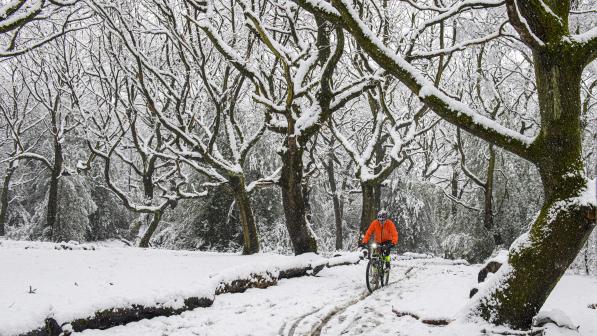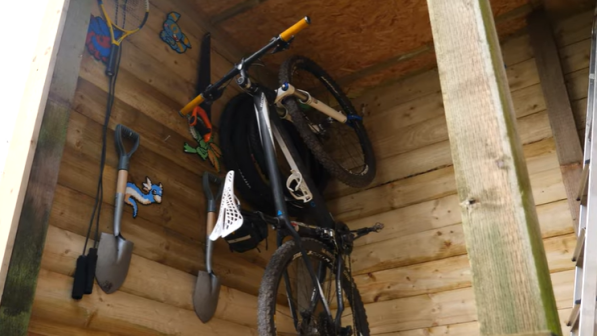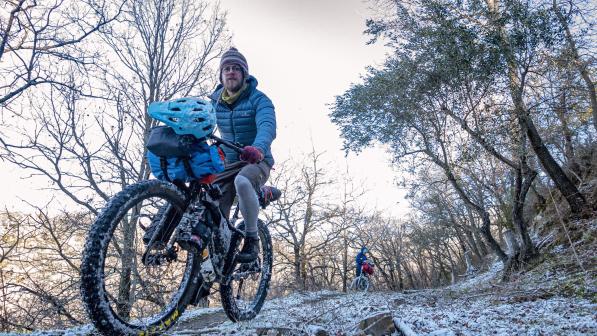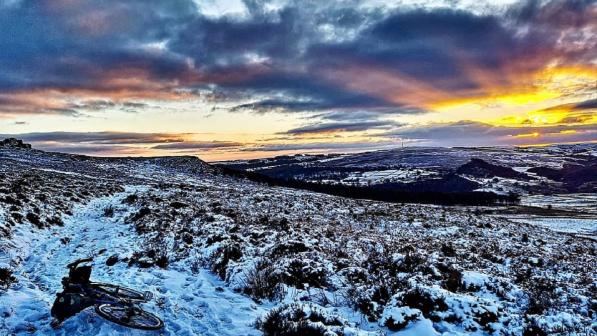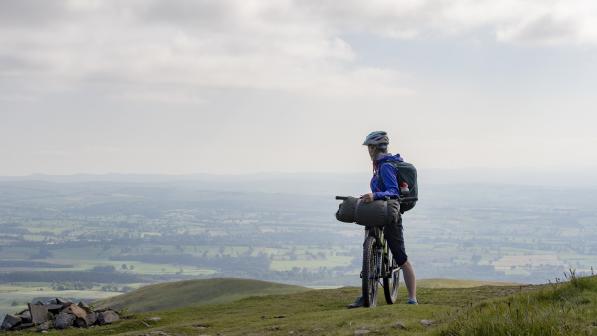Guide to winter off-road cycling

If you want to keep riding through the winter, you need to prepare yourself, and that starts with your mentality. If you can see the (spring) light at the end of the (wet, winter) tunnel, and ride through it to get there you will be able to start your spring season off on a roll.
The first battle is the one of motivation, as your riding mojo can easily slip into hibernation during the long winter months, so here are a few tips to help overcome that sofa inertia.
- Adjust your expectations – aim to have fun and improve your skills, rather than go on big rides and improve fitness; unless you are a pro-rider, winter doesn’t need to become a total suffer-fest
- Arrange to ride with friends – it’s harder to give up when you’re accountable to someone else
- Have something to aim for – enter a late spring event to provide some focus and motivation
- Have your bike and equipment organised and weather ready; use mudguards, metallic (sintered) brake pads and mud tyres. Have waterproof socks, shoes and trousers, clear glasses, warm gloves, a changing towel and bike wash and so on to make life easier and more comfortable
- Plan a nice café stop in along the ride, or a pub at the end and reward yourself for getting out
- Choose a good place to ride that isn’t so affected by the winter filth – read on for more on this…

When it all gets too much like hard work, you could try heading somewhere warmer like Lanzarote or Mallorca (possible to do by train and ferry), where your spirits will be lifted by the warmer, drier weather with some great riding. Having a trip like this planned also provides something to look forward, too, and even ‘train’ for.
If you’re not a fan of using a turbo trainer then spinning classes or the new digital offerings such as Zwift can remove the tedium of starring at a garage wall.
Your riding mojo can easily slip into hibernation during the long winter months
Max Darkins, Rough Ride Guide
Sometimes a short ‘break’ from cycling can re-kindle your enthusiasm, though, so try doing something different like swimming, yoga, or joining a local advocacy trail group, like Peak District MTB. These groups help maintain and improve the trails and access, and build relationships with the local community, while also getting you out and earning bike karma points.
Winter riding skills
Riding in slippery mud can be tiring and demoralising, but it’s great fitness training (think of it more as resistance training…) and most definitely skill enhancing!
The following tips are things you could try to help you ride more confidently in tricky conditions:
- Be in the ‘ready’ position as much as possible, with body relaxed, arms bent and back parallel to the top tube, pedals level, heels dropped and weight central
- Look ahead down the trail, at the line you want to take, rather than obstacles, looking for areas that offer traction, such as ruts, berms and dry firm ground
- Try to avoid turning the bars and keep movements smooth by turning your bike with your body instead. Your upper body should remain calm and centred on the bike, with enough space to move around in any direction to retain balance
- If you need to get the bigger side knobbles of your tyres gripping the ground, lean the bike, not your body
- Brake before turns and ‘feather’ your brakes, being careful not to use the front too firmly or lock out the wheel, and push yourself down into the bike and trail, to aid traction and braking power
- Keep your momentum by looking up, plan your braking and pump the trail where you can
- Go through puddles; not only does it stop the puddle getting wider, but it is usually firm underneath. However, you don’t know what lies beneath, so when entering a puddle, lift the front wheel, have cranks level, hover off the saddle, drop your heels and get your weight back in anticipation of what you can’t see underneath
- When riding through deep mud, aim for existing tracks as these will be slightly compacted, and firmer to ride
- Try to ride over roots straight on at 90 degrees, and if possible, lift the front wheel over (but keep your weight central, not back), keep limbs loose and shift your weight to where you have traction
- Pedal in smooth powerful strokes, using a lower cadence and change down a couple of gears. Use a larger cog as you are less likely to slip on a larger cog and less likely to stall if slowed down
- Use low tyre pressures as they provide more grip. However, with inner tubes, these can squirm around and give you pinch flats, so tubeless is highly recommended, especially as fixing a flat tyre in the mud is something you want to avoid.
Where to ride
Planning is crucial to enjoying rides during the winter months.
Chances are you’ll know where to avoid locally, but if you are planning a trip further afield then do a bit of research about different areas that may fare better than your own stomping ground when the weather takes a turn for the worse.

If you need to get some big miles in over the winter choose a relatively flat and fast route which is easy to navigate, so that you can keep a steady pace and stay warm.
Canal paths and trails that follow disused railway lines are good for this. Alternatively, try opting for short, hard, punchier rides with some stiff climbs that will keep you warm, and technical descents that will keep it fun.
Popular locations and horse-riding routes are best avoided in the winter; instead stay on higher ground which drains better. I also keep away from moorland and lowland, fields and some woodlands too.
Popular locations and horse-riding routes are best avoided in the winter
Max Darkins
Trees, being bare in the winter, don’t absorb water like they do in the summer, and trails will be more sheltered from the wind, so tend to stay wetter longer, and leave slippery wet roots lying in wait. Saying that, I enjoy the technical challenge woods often provide and the trees can also give you some shelter from the wind.
Another favourite of mine in the winter is an urban MTB ride. This involves connecting things like BMX and pump tracks, scrubland, woods and parks using little back-alleys, obscure paths and bridleways.
Being able just jump on your bike and roll out the door is so much easier to do, too, as it negates the bother of loading a bike into the car, or more to the point packing up filthy bike and kit afterwards.
It’s an interesting and useful way to way to explore your local area, too. I’ve also used my local urban bike ride route in the summer with my family and other families and the kids love it! You could even see if you could incorporate a ride through at a fast food drive-thru along the way!
Man-made trails
There are lots of great trail centres around the UK now, which are built to withstand heavy use and wet weather, and offer a range of useful facilities like a bike wash, café and toilets, making your ride much easier and more comfortable.
These are definitely worth a visit in the winter as you can be guaranteed a good ride when your local trails may or may not be trashed. See Rough Ride Guide for a comprehensive list.
Max Darkins runs Rough Ride Guide and helped devise the route for the Great North Trail
